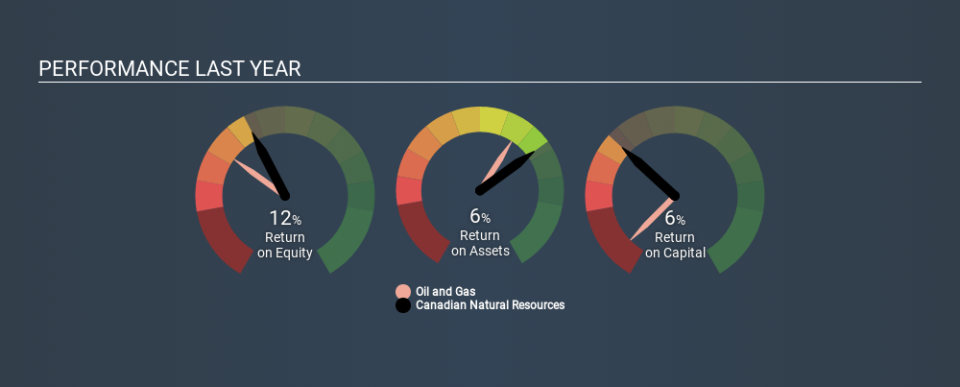Is Canadian Natural Resources Limited (TSE:CNQ) Investing Effectively In Its Business?

Today we are going to look at Canadian Natural Resources Limited (TSE:CNQ) to see whether it might be an attractive investment prospect. In particular, we'll consider its Return On Capital Employed (ROCE), as that can give us insight into how profitably the company is able to employ capital in its business.
First up, we'll look at what ROCE is and how we calculate it. Next, we'll compare it to others in its industry. Last but not least, we'll look at what impact its current liabilities have on its ROCE.
Return On Capital Employed (ROCE): What is it?
ROCE measures the 'return' (pre-tax profit) a company generates from capital employed in its business. All else being equal, a better business will have a higher ROCE. Overall, it is a valuable metric that has its flaws. Author Edwin Whiting says to be careful when comparing the ROCE of different businesses, since 'No two businesses are exactly alike.
How Do You Calculate Return On Capital Employed?
The formula for calculating the return on capital employed is:
Return on Capital Employed = Earnings Before Interest and Tax (EBIT) ÷ (Total Assets - Current Liabilities)
Or for Canadian Natural Resources:
0.063 = CA$4.5b ÷ (CA$79b - CA$7.9b) (Based on the trailing twelve months to September 2019.)
So, Canadian Natural Resources has an ROCE of 6.3%.
Check out our latest analysis for Canadian Natural Resources
Does Canadian Natural Resources Have A Good ROCE?
ROCE can be useful when making comparisons, such as between similar companies. It appears that Canadian Natural Resources's ROCE is fairly close to the Oil and Gas industry average of 5.4%. Setting aside the industry comparison for now, Canadian Natural Resources's ROCE is mediocre in absolute terms, considering the risk of investing in stocks versus the safety of a bank account. Readers may find more attractive investment prospects elsewhere.
Canadian Natural Resources reported an ROCE of 6.3% -- better than 3 years ago, when the company didn't make a profit. That implies the business has been improving. You can click on the image below to see (in greater detail) how Canadian Natural Resources's past growth compares to other companies.
Remember that this metric is backwards looking - it shows what has happened in the past, and does not accurately predict the future. ROCE can be deceptive for cyclical businesses, as returns can look incredible in boom times, and terribly low in downturns. This is because ROCE only looks at one year, instead of considering returns across a whole cycle. Remember that most companies like Canadian Natural Resources are cyclical businesses. What happens in the future is pretty important for investors, so we have prepared a free report on analyst forecasts for Canadian Natural Resources.
How Canadian Natural Resources's Current Liabilities Impact Its ROCE
Liabilities, such as supplier bills and bank overdrafts, are referred to as current liabilities if they need to be paid within 12 months. The ROCE equation subtracts current liabilities from capital employed, so a company with a lot of current liabilities appears to have less capital employed, and a higher ROCE than otherwise. To counter this, investors can check if a company has high current liabilities relative to total assets.
Canadian Natural Resources has current liabilities of CA$7.9b and total assets of CA$79b. Therefore its current liabilities are equivalent to approximately 10% of its total assets. It is good to see a restrained amount of current liabilities, as this limits the effect on ROCE.
Our Take On Canadian Natural Resources's ROCE
If Canadian Natural Resources continues to earn an uninspiring ROCE, there may be better places to invest. You might be able to find a better investment than Canadian Natural Resources. If you want a selection of possible winners, check out this free list of interesting companies that trade on a P/E below 20 (but have proven they can grow earnings).
If you are like me, then you will not want to miss this free list of growing companies that insiders are buying.
If you spot an error that warrants correction, please contact the editor at editorial-team@simplywallst.com. This article by Simply Wall St is general in nature. It does not constitute a recommendation to buy or sell any stock, and does not take account of your objectives, or your financial situation. Simply Wall St has no position in the stocks mentioned.
We aim to bring you long-term focused research analysis driven by fundamental data. Note that our analysis may not factor in the latest price-sensitive company announcements or qualitative material. Thank you for reading.

 Yahoo Finance
Yahoo Finance 
